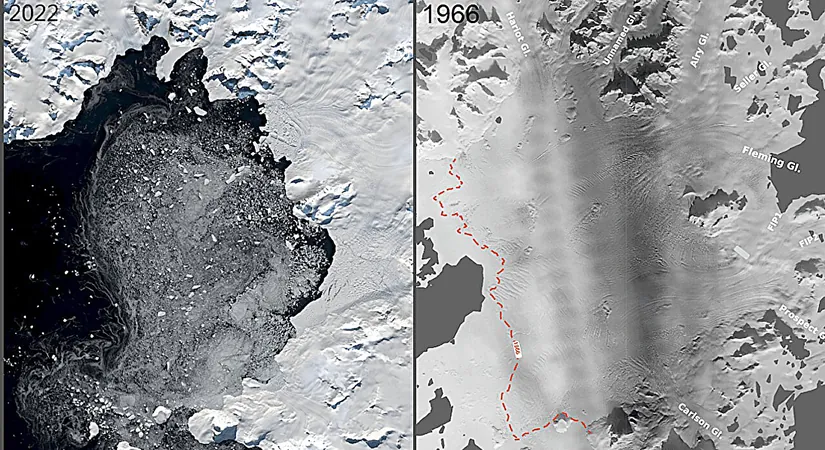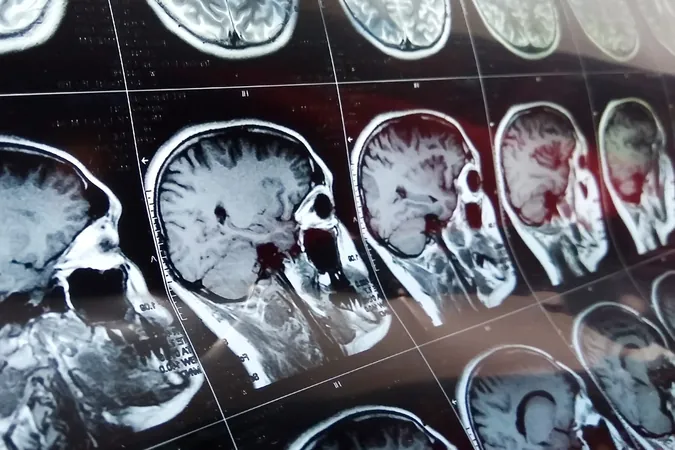
Unlocking the Secrets of Ice Shelf Collapse: Old Photos Lead to New Discoveries
2025-07-08
Author: Mei
Imagine a moment captured in time—a single photograph of the icy expanse of Antarctica in 1966 that would lay the groundwork for groundbreaking research on climate change. This pivotal image, snapped by a U.S. Navy photographer over the Wordie Ice Shelf, has become a crucial piece in the puzzle of understanding the future of our planet.
Turning Back the Clock with Historical Data
Scientists at the University of Copenhagen have taken that one photo and transformed it into a comprehensive dataset, using it alongside hundreds of images taken from 1966 to 1969. This innovative technique allows researchers to reconstruct the gradual collapse of the Wordie Ice Shelf, proving that ice shelf collapses are not as instantaneous as previously believed.
A New Tool for Ice Shelf Monitoring
Mads Dømgård, the lead author of the study, emphasizes the significance of this research: "We've pinpointed several indicators that signal the beginning of an ice shelf’s collapse, insights we expect to see in other at-risk shelves too. The dataset acts as a new tool for assessing how far along the collapse process is, offering real-time checks on ice shelves that are vulnerable or already collapsing."
The Ripple Effects Extend Beyond Antarctica
Though the Wordie Ice Shelf collapse resulted in a mere millimeter of sea level rise, its ramifications are substantial. This minor shift acted like a popped cork, allowing glaciers behind it to flow more freely into the ocean. Larger ice shelves, like Ronne and Ross, contain enough ice to potentially elevate global sea levels by a staggering five meters. The melting of Antarctica's ice is a global issue; as it drips away, the seismic shifts in sea level are felt in distant regions, including Northern Hemisphere countries such as Denmark.
Unveiling the Real Culprits Behind Collapse
Employing a technique known as structure-from-motion photogrammetry, researchers stitched together overlapping historical photographs into detailed 3D models, unveiling the ice shelf's structural changes over time. Contrary to earlier beliefs that warmer air and surface meltwater lakes were the primary causes of the collapse, the study reveals that rising sea temperatures are the main driver, highlighting the critical importance of underwater conditions.
A Slower, Sneakier Threat?
This research also challenges the notion that ice shelf collapses occur rapidly. According to Anders Anker Bjørk, an assistant professor involved in the study, the findings suggest that these collapses may be slower than previously thought. While this could imply a slight reduction in the immediacy of violent sea-level rises, it also means the process could become irreversible once it begins. Bjørk strongly advocates for urgent action, saying, "We need to prioritize halting greenhouse gas emissions now, rather than waiting for a future crisis."
A Call to Action: Understanding the Icy Truth
The revelations from this study serve as a crucial wake-up call. Even slow-moving environmental changes can lead to catastrophic consequences. By expanding our understanding of how ice shelves collapse, we have a critical opportunity to act now—before it’s too late.
The full study is published in Nature Communications, showcasing the vital need to understand and combat climate change.


 Brasil (PT)
Brasil (PT)
 Canada (EN)
Canada (EN)
 Chile (ES)
Chile (ES)
 Česko (CS)
Česko (CS)
 대한민국 (KO)
대한민국 (KO)
 España (ES)
España (ES)
 France (FR)
France (FR)
 Hong Kong (EN)
Hong Kong (EN)
 Italia (IT)
Italia (IT)
 日本 (JA)
日本 (JA)
 Magyarország (HU)
Magyarország (HU)
 Norge (NO)
Norge (NO)
 Polska (PL)
Polska (PL)
 Schweiz (DE)
Schweiz (DE)
 Singapore (EN)
Singapore (EN)
 Sverige (SV)
Sverige (SV)
 Suomi (FI)
Suomi (FI)
 Türkiye (TR)
Türkiye (TR)
 الإمارات العربية المتحدة (AR)
الإمارات العربية المتحدة (AR)